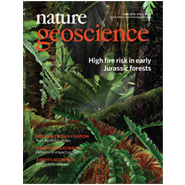Posted 06 June 2010
Forests more prone to wildfires as climate heats up
A change in vegetation leaf shape, alongside warmer temperatures and more frequent storms, led to a five-fold increase in natural wildfires in East Greenland millions of years ago, according to new research published on the cover of Nature Geoscience.
With these findings, University College Dublin scientists claim that current rising levels of atmospheric CO2 contributing to global warming, could lead to increasing numbers of wildfires.
Wildfires are a growing natural hazard in most regions of the United States, posing a threat to life and property, particularly where native ecosystems meet developed areas.
Pictured far right: Cover of the Nature Geoscience June 2010 showing a scientific illustration of Greenland's vegetation 200 Myr ago.
According to the US Geological Survey, more land has been affected by wildfires in recent years than at any time since the 1960s. In 2004, wildfires burned more than 8 million acres in 40 States in the US. The greater Yellowstone National Park fire of 1988 burned more than 1.2 million acres.
“We selected the boundary between the Triassic-Jurassic period, 200 million years ago, as it represents a natural global warming event, that is believed to have led to a catastrophic mass extinction event,” says Dr Claire Belcher from the UCD School of Biology and Environmental Science who led the study.
“By studying how plants and fire changed in the ancient past and using experiments on living plants – much like those that grew 200 million years ago in East Greenland – we identified the conditions under which ecosystems became more flammable.”
According to Dr Belcher, a warming climate and high levels of CO2 in the atmosphere caused plants to evolve narrower leaves to prevent them from losing water as quickly under increased temperatures.
“Our laboratory experiments show that plants of this shape are more flammable and therefore more prone to wildfires through lightning strikes,” explains Dr Belcher.
The findings help scientists to understand how climate-driven changes in vegetation can cause increases in the flammability of plants. The research also helps predict that the planet may become more flammable as global warming continues.
The laboratory experiments were conducted at the University of Edinburgh’s BRE Centre for Fire Safety Engineering.
"This research brought together scientists from very different backgrounds, and doing so has given us insights into ancient wildfires that we might otherwise not have had,” says Dr Guillermo Rein from the University of Edinburgh’s School of Engineering, who co-authored the work.
“This is the first time our flammability technology has been applied to test geoscience hypothesis and highlights how new ideas can be formed when scientists from very different backgrounds work together."
Researchers from the University of Oxford and the Field Museum of Natural History in Chicago were also involved in the study. Funding for the project was provided by the EU Marie Curie programme.
(Produced by UCD University Relations)

